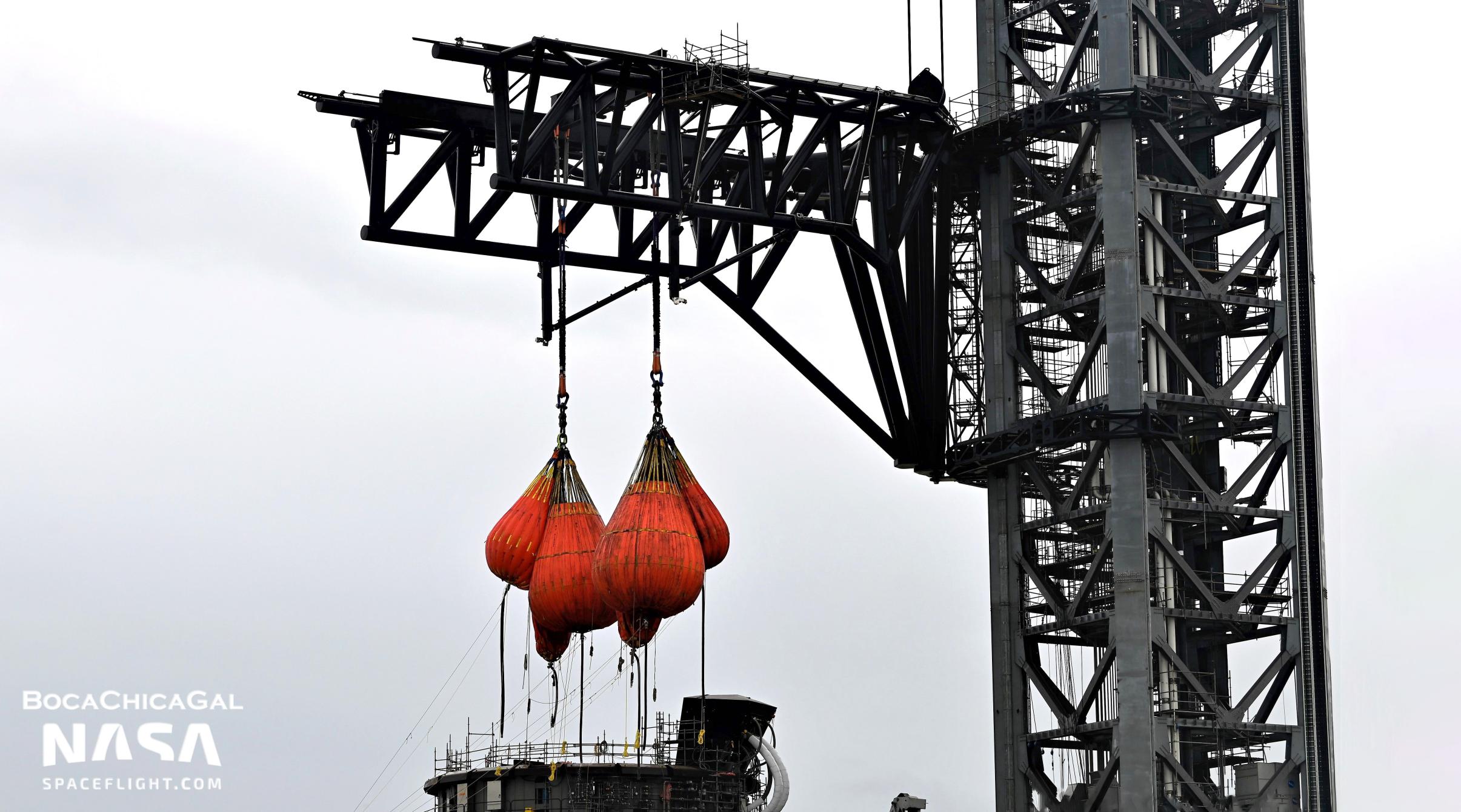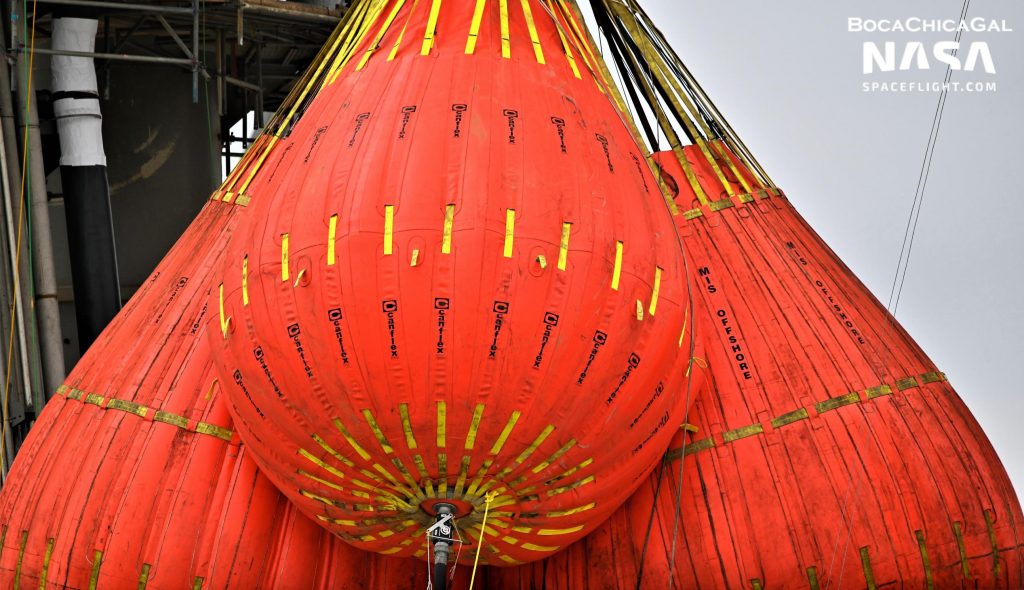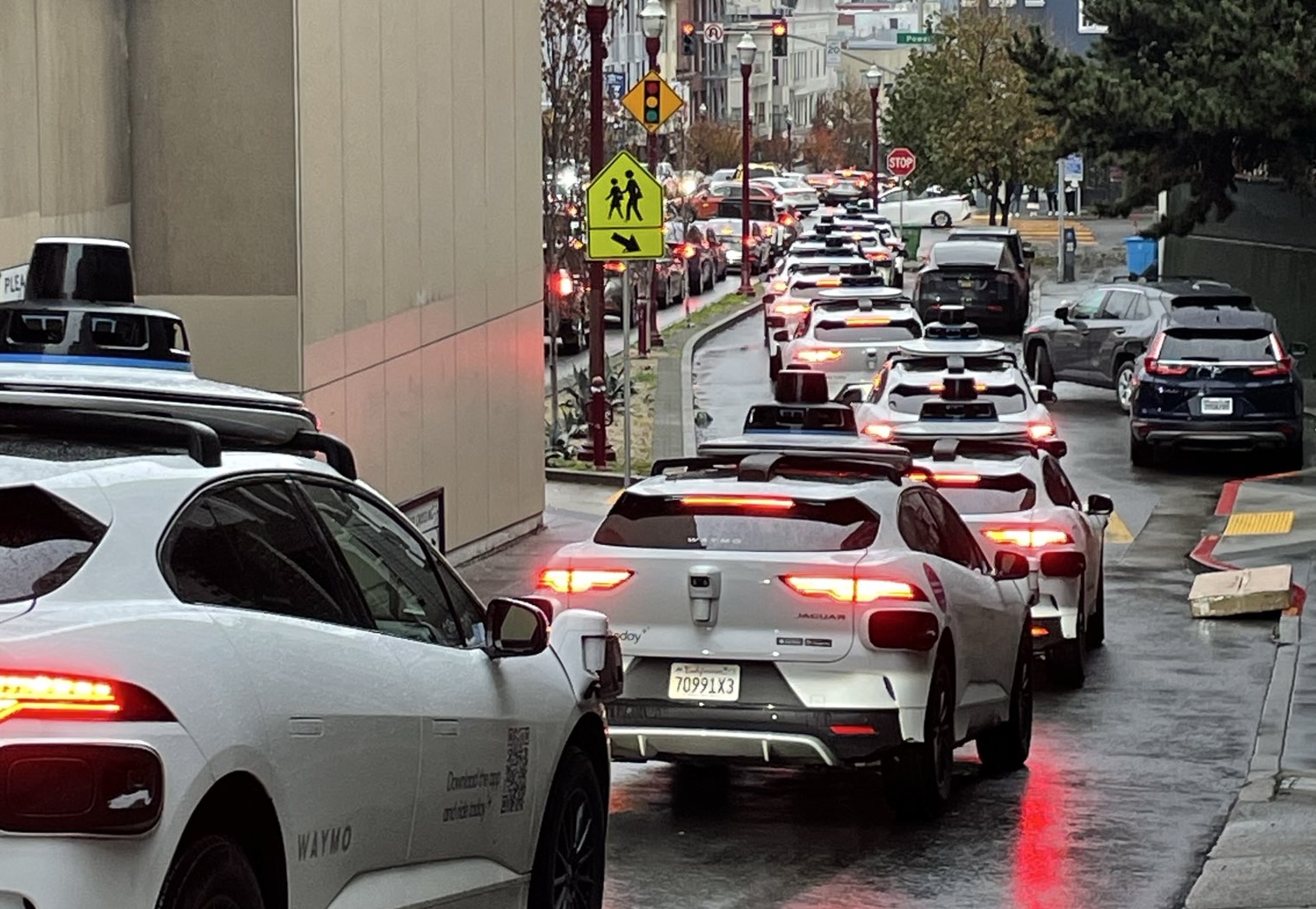

News
SpaceX stress-tests Starship-catching arms with giant water balloons
SpaceX has begun testing Starbase’s rocket-catching arms with ballast to simulate the weight of Starship and Super Heavy.
SpaceX started the process of proof testing those arms about a week ago, beginning with some basic calibration work. Together, the three arms and launch tower amount to a giant custom-built robot that SpaceX CEO Elon Musk has deemed “Mechazilla.” Controlled with a complex system of hydraulic and electromechanical actuators spread throughout each structure, SpaceX must calibrate all of those devices to enable the full range of motion the arms are meant to be capable of. To do so, SpaceX appeared to actuate both catch arms (also known as “chopsticks”) as far as they were able to move on January 4th, producing data that could be fed back into the system’s control software to properly set limits of motion.
A handful of days later, arm testing continued, with SpaceX lifting the carriage higher than it had traveled before and demonstrating more complex longitudinal movements that required synchronized motion of both arms. On January 9th, SpaceX performed the most ambitious arm testing yet, nearly lifting the arms to the top of their ~140 meter (~460 ft) tall launch tower backbone to simulate the range of vertical motion required to lift and stack Starship and Super Heavy.

SpaceX also installed a temporary frame meant to simulate a Starship or Super Heavy booster, foreshadowing additional testing planned in the coming days. That jig upped the stakes for the longitudinal actuation portion of January 9th’s testing, as anything less than the precise, synchronized movement of both arms could have caused the heavy steel frame to fall hundreds of feet onto a range of equipment and structures directly below it. Thankfully, the arms performed well and returned to their resting position without issue.
On January 11th, SpaceX proceeded to install six ‘water bags’ – three to a side – on the Starship simulator frame. Amounting to giant, heavy-duty water balloons, those bags are routinely used to stress-test large structures and devices by simulating payloads that might be too expensive or inconvenient to use solely for testing purposes. With those seemingly empty bags attached, SpaceX proceeded to move the catch arms up and down the full length of the launch tower at record speed, taking about seven minutes to climb and descend ~120 meters (~400 ft) – averaging a brisk 0.6 mph or 1 km/h.
Here is a video from Giga Texas of this type of mass simulator! pic.twitter.com/uHfah45WVt— Zack Golden (@CSI_Starbase) January 11, 2022
On January 12th, SpaceX filled the balls with water, producing some… interesting… visuals. Ridiculous appearances aside, the six bags SpaceX chose to use could be 20, 35, or 50-ton variants, meaning that all six could weigh anywhere from 120 to 300 tons (264,000-660,000 lb) if fully filled. In other words, perfect for simulating the dry masses of Starship (roughly 80-120 tons) and Super Heavy (150-200+ tons).


SpaceX did appear to fully fill around four of the six bags and partially filled the other two, causing the whole arm structure to visibly sag during the fill process as the weight of the ballast stretched the several-inch-thick steel cable holding the whole device aloft. In the late afternoon, the laden arms lifted around 10-20 meters and rotated left and right, partially demonstrating the process of rotating a lifted Starship or Super Heavy into position for stacking or launch mount installation. They were never lifted high enough to truly demonstrate that ability, though, and were lowered back to the ground soon after.
As of 10pm CST, January 12th, the water bags appear to have been fully drained after their first excursion. It’s likely that load-testing will continue over the next several days or weeks – SpaceX may just want to avoid leaving the arms fully loaded overnight.

Elon Musk
Tesla’s Elon Musk gives timeframe for FSD’s release in UAE
Provided that Musk’s timeframe proves accurate, FSD would be able to start saturating the Middle East, starting with the UAE, next year.

Tesla CEO Elon Musk stated on Monday that Full Self-Driving (Supervised) could launch in the United Arab Emirates (UAE) as soon as January 2026.
Provided that Musk’s timeframe proves accurate, FSD would be able to start saturating the Middle East, starting with the UAE, next year.
Musk’s estimate
In a post on X, UAE-based political analyst Ahmed Sharif Al Amiri asked Musk when FSD would arrive in the country, quoting an earlier post where the CEO encouraged users to try out FSD for themselves. Musk responded directly to the analyst’s inquiry.
“Hopefully, next month,” Musk wrote. The exchange attracted a lot of attention, with numerous X users sharing their excitement at the idea of FSD being brought to a new country. FSD (Supervised), after all, would likely allow hands-off highway driving, urban navigation, and parking under driver oversight in traffic-heavy cities such as Dubai and Abu Dhabi.
Musk’s comments about FSD’s arrival in the UAE were posted following his visit to the Middle Eastern country. Over the weekend, images were shared online of Musk meeting with UAE Defense Minister, Deputy Prime Minister, and Dubai Crown Prince HH Sheikh Hamdan bin Mohammed. Musk also posted a supportive message about the country, posting “UAE rocks!” on X.
FSD recognition
FSD has been getting quite a lot of support from foreign media outlets. FSD (Supervised) earned high marks from Germany’s largest car magazine, Auto Bild, during a test in Berlin’s challenging urban environment. The demonstration highlighted the system’s ability to handle dense traffic, construction sites, pedestrian crossings, and narrow streets with smooth, confident decision-making.
Journalist Robin Hornig was particularly struck by FSD’s superior perception and tireless attention, stating: “Tesla FSD Supervised sees more than I do. It doesn’t get distracted and never gets tired. I like to think I’m a good driver, but I can’t match this system’s all-around vision. It’s at its best when both work together: my experience and the Tesla’s constant attention.” Only one intervention was needed when the system misread a route, showcasing its maturity while relying on vision-only sensors and over-the-air learning.
News
Tesla quietly flexes FSD’s reliability amid Waymo blackout in San Francisco
“Tesla Robotaxis were unaffected by the SF power outage,” Musk wrote in his post.

Tesla highlighted its Full Self-Driving (Supervised) system’s robustness this week by sharing dashcam footage of a vehicle in FSD navigating pitch-black San Francisco streets during the city’s widespread power outage.
While Waymo’s robotaxis stalled and caused traffic jams, Tesla’s vision-only approach kept operating seamlessly without remote intervention. Elon Musk amplified the clip, highlighting the contrast between the two systems.
Tesla FSD handles total darkness
The @Tesla_AI account posted a video from a Model Y operating on FSD during San Francisco’s blackout. As could be seen in the video, streetlights, traffic signals, and surrounding illumination were completely out, but the vehicle drove confidently and cautiously, just like a proficient human driver.
Musk reposted the clip, adding context to reports of Waymo vehicles struggling in the same conditions. “Tesla Robotaxis were unaffected by the SF power outage,” Musk wrote in his post.
Musk and the Tesla AI team’s posts highlight the idea that FSD operates a lot like any experienced human driver. Since the system does not rely on a variety of sensors and a complicated symphony of factors, vehicles could technically navigate challenging circumstances as they emerge. This definitely seemed to be the case in San Francisco.
Waymo’s blackout struggles
Waymo faced scrutiny after multiple self-driving Jaguar I-PACE taxis stopped functioning during the blackout, blocking lanes, causing traffic jams, and requiring manual retrieval. Videos shared during the power outage showed fleets of Waymo vehicles just stopping in the middle of the road, seemingly confused about what to do when the lights go out.
In a comment, Waymo stated that its vehicles treat nonfunctional signals as four-way stops, but “the sheer scale of the outage led to instances where vehicles remained stationary longer than usual to confirm the state of the affected intersections. This contributed to traffic friction during the height of the congestion.”
A company spokesperson also shared some thoughts about the incidents. “Yesterday’s power outage was a widespread event that caused gridlock across San Francisco, with non-functioning traffic signals and transit disruptions. While the failure of the utility infrastructure was significant, we are committed to ensuring our technology adjusts to traffic flow during such events,” the Waymo spokesperson stated, adding that it is “focused on rapidly integrating the lessons learned from this event, and are committed to earning and maintaining the trust of the communities we serve every day.”
News
Waymo scrutinized after self-driving taxis cause traffic jams during SF blackout
It’s not farfetched to speculate that it would have been a doomsday scenario for Tesla had FSD behaved this way.

A power outage across San Francisco over the weekend forced numerous Waymo self-driving taxis to stop at darkened intersections and cause traffic blockages in multiple locations across the city. The disruption left riders stranded, frustrated drivers blocked, and city officials stepping in as the Alphabet-owned company temporarily suspended service amid the widespread gridlock.
Needless to say, it would likely have been a doomsday scenario for Tesla had FSD behaved in a similar way, especially if fleets of its robotaxis blocked traffic for numerous drivers.
Power outage halts Waymo fleet
The outage knocked out electricity for tens of thousands of customers, leaving traffic signals dark across large parts of the city, as noted in a report from the New York Times. Waymo vehicles began stopping at intersections and remained stationary for extended periods, seemingly unable to operate. Tow truck operators worked through the night removing immobilized vehicles, while videos circulated online showing Waymos with hazard lights flashing as traffic backed up around them.
Waymo later confirmed that it had paused its Bay Area ride-hailing service after the San Francisco mayor’s office contacted the company about the congestion its vehicles were contributing to. Service began coming back online shortly after 3:30 p.m. local time, though some users still reported being unable to request rides. Waymo maintained that no injuries or accidents were reported during the outage.
Autonomous cars during emergencies
The incident surprised industry observers since autonomous vehicles are designed to function during signal outages and temporary connectivity losses. Waymo stated that its vehicles treat nonfunctional signals as four-way stops, but “the sheer scale of the outage led to instances where vehicles remained stationary longer than usual to confirm the state of the affected intersections. This contributed to traffic friction during the height of the congestion.” Experts suggested the problem may have been linked to the vehicles’ reliance on remote assistance teams, which help resolve complex situations the cars cannot handle independently.
“Yesterday’s power outage was a widespread event that caused gridlock across San Francisco, with non-functioning traffic signals and transit disruptions. While the failure of the utility infrastructure was significant, we are committed to ensuring our technology adjusts to traffic flow during such events,” the Waymo spokesperson stated, adding that it is “focused on rapidly integrating the lessons learned from this event, and are committed to earning and maintaining the trust of the communities we serve every day.”








